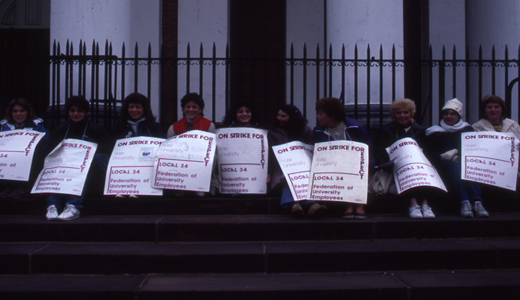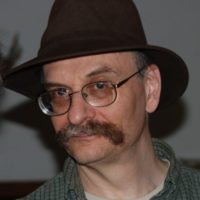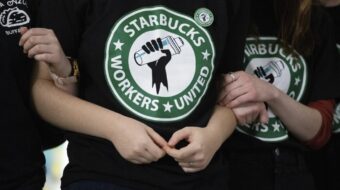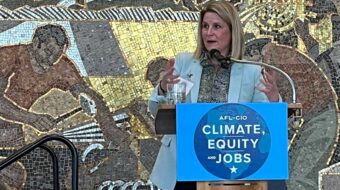
NEW HAVEN – Scores of Local 34 Unite Here members at Yale and their sisters and brothers from Locals 35 and GESO gathered on Cross Campus during lunch break last Wednesday for ballons, speeches and birthday cake. to celebrate the 30th anniversary of the historic strike by Local 34 clerical and technical workers which won their first union contract.
Despite current battles brewing, Yale’s new president, Peter Salovey, came by to shake hands with each of the workers, recognizing the respect they had won in the hard fought 1984 battle.
Two days later, on the actual anniversary, the Peoples Center was filled with retirees and current Yale workers telling their stories. A video of strike photos taken by Local 34 member Joe Taylor was premiered, followed by a panel and then open discussion highlighting recollections of those who participated and led the organizing drive and strike.
“We weren’t thinking about making history,” said former Local 34 president Laura Smith. “This was our lives.”
The 1984 strike was a turning-point struggle in the United States for unions, for women, and for the working class.
Many currents contributed to the victory. The civil rights and anti Vietnam war movements had changed attitudes of millions of youth who brought those new attitudes with them into the workforce and into their unions. At the same time, there was a flood of women into the workforce, both reflecting and contributing to the growth of the women’s movement and its working-class component. In the late 1950s, 42 percent of working-age women (aged 25-54) were in the workforce. By 1984, this had increased to 68 percent, with most of that increase in the previous decade. This was also the decade that saw the start of the long stagnation and decline of men’s wages and the increasing proportion of women whose income was essential to maintain their family.
The successful organizing drive and strike were conducted in the teeth of the anti-union offensive signaled by President Reagan’s 1981 breaking of the air traffic controllers’ union. It was one of a handful of nationally-watched struggles that helped revive and expand a militant, membership-based class struggle unionism and propel a new generation to leadership of the national labor movement.
After World War II, the big corporations used the cold war atmosphere and government repression to purge militant leaders from the labor movement, and impose a business unionism model. “The union” often became an outside service that workers hired with their union dues. But as early as the 1960s, unions like 1199 were challenging this model (including in New Haven, where it gained a foothold in Yale New Haven Hospital). The Local 34 organizing drive at Yale continued to break with the business union model by emphasizing working-class struggle and class unity, though it did not use those terms. Some features of the organizing drive and strike:
ñ The union drive stressed membership involvement. As several veterans commented, other unions said, “Join us and we will make things better.” Local 34 said, “Join us and we will show you how to make things better.”
ñ The union emphasized you only win what you are strong enough to win. When workers asked, “Can management do that?” the reply was always, “Only if you let them get away with it.”
ñ The union stressed solidarity with the blue collar workers in Local 35, and with the labor movement.
ñ The union identified with social movements, especially the civil rights and women’s movements.
Today, the struggles of fast food, big box retail, janitorial, car wash and all low-wage workers are in this tradition; Locals 34 and 35 today, while facing challenges to defend their hard-won gains against outsourcing and speedup at Yale, are in the forefront of a labor-community coalition demanding good jobs for New Haven residents. And at the state and national levels, the organized participation of rank-and-file union leaders and members is playing a critical role in preventing the complete takeover of the federal and state governments by far-right ideologues who act as fronts for corporate interests.
In honor of the anniversary, Political Affairs has reposted an analysis of the strike by some of the participants, which was first published in July 1985.
Photo: 1984 strike by clerical and technical workers at Yale University. Joe Taylor












Comments